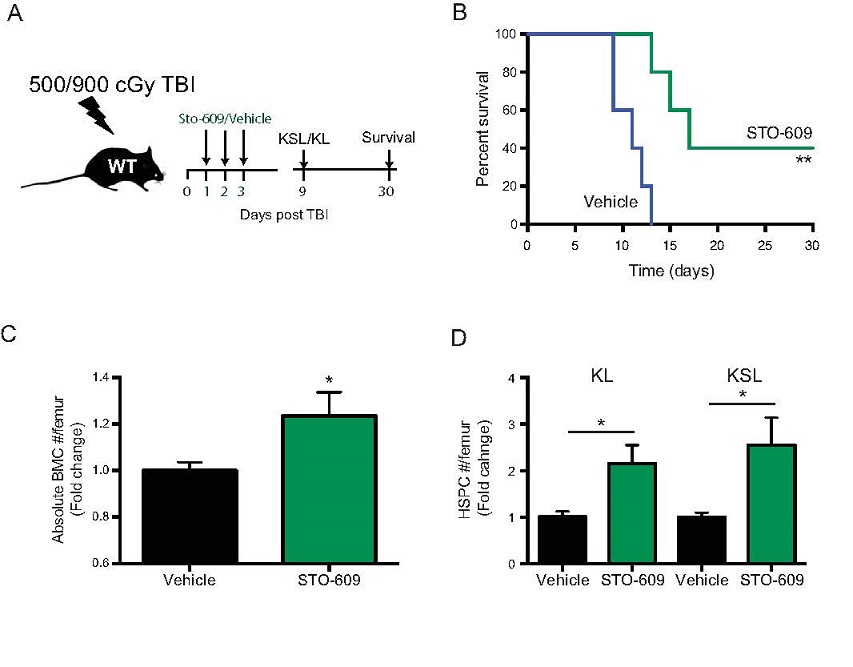Peer Reviewed Cancer



Posted March 14, 2018
Nelson J. Chao, M.D., Duke University, Idea Award with Special Focus, Cancers Related to Radiation Exposure

Nelson J. Chao, M.D., Duke University
Exposure to ionizing radiation, which includes high-energy types of radiation like x-rays and gamma radiation, increases the risk of developing blood cancers like leukemia and multiple myeloma. Ionizing radiation can cause DNA damage in immature blood cells, called hematopoietic stem cells (HSC). The mutated HSC then compete with normal HSC for biological niches and over time create a pro-cancer environment. Active duty Service members may be exposed to radiation sources during military activities and thus be at risk for developing different types of cancers, especially blood cancers.
In fiscal year 2014, Drs. Nelson Chao and Luigi Racioppi (Co-PI) received an Idea Award with Special Focus to investigate whether inhibition of a specific signaling molecule, calcium/calmodulin-dependent kinase kinase (CaMKK2), could prevent abnormal cell growth and decrease the risk of developing cancer after radiation exposure. This project was based on preliminary findings demonstrating that mouse models lacking CaMKK2 (named Camkk2-/- mice) show accelerated recovery after total body irradiation. Additionally, CaMKK2 is an attractive therapeutic target because small molecule inhibitors of CaMKK2 activity are already available.
The first half of this project aimed to establish the function of CaMKK2 in the progression of blood cancer tumors. Using mouse models of both lymphoma and multiple myeloma, Drs. Chao and Racioppi confirmed that mice that did not have CaMKK2 (Camkk2-/-) demonstrated either significantly reduced tumor burden or no cancer at all, respectively, as compared to wild type/normal mice that had CaMKK2. Next, Drs. Chao and Racioppi explored the relationship between myeloid cells' maturation and blood cancer initiation. Myeloid cells are a heterogeneous population of hematopoietic cells that can differentiate into many cell types, including immune-suppressing/tumor-promoting cells called myeloid derived suppressor cells (MDSC) and immunogenic/anti-tumor cell types called dendritic cells. They tested the hypothesis that CaMKK2 is critical in directing the differentiation program of myeloid cell maturation in tumor-bearing mice. Using a mouse model of lymphoma, Drs. Chao and Racioppi confirmed that Camkk2-/- mice had significantly lower MDSC cell counts than wild-type mice. Furthermore, when Camkk2-/- mice were given MDSC from a wild-type mouse, they exhibited increased tumor growth. Most importantly, they demonstrated that immunosuppressive MDSC isolated from Camkk2-/- mice have a remarkable ability to differentiate in the more immunogenic dendritic cells (DC). Overall, these studies showed that CaMKK2 is an important regulator of MDSC development, and the inhibition of this enzyme promotes DC generation and stimulates the anti-tumor immune response.
For the second half of the project, Drs. Chao and Racioppi hypothesized that CaMKK2 regulates the regeneration of HSC following radiation damage. They also predicted that genetic deletion or pharmacological blocking of this enzyme would decrease the radiation-induced bone marrow damage and accelerate blood cell formation. To test this hypothesis, they first demonstrated that Camkk2-/- mice exposed to ionizing radiation have a better survival rate and a faster blood cell recovery compared to control mice. Interestingly, Drs. Chao and Racioppi also found that irradiated mice treated with a CaMKK2 inhibitor 24 hours after exposure have a better survival rate and a faster recovery of HSC and blood cells compared to untreated animals.
For mice treated with CaMKK2 inhibitors, the faster recovery of HSC and the enhanced ability to generate more immunogenic cell types would reduce the long-term risk of developing radiation-induced lymphoma. Therefore, Drs. Chao and Racioppi treated mice with a single dose of a CaMKK2 inhibitor after each of four total-body radiation exposures. They observed that up to 150 days post-irradiation, the mice treated with the CaMKK2 inhibitor showed improved survival rates compared to untreated mice. These results provide preliminary support for the prophylactic use of CaMKK2 inhibitors after radiation exposure to prevent blood tumor formation.
Dr. Chao and Racioppi are currently optimizing dosing regimens of the CaMKK2 inhibitor and working with collaborators to test related molecules that may have improved function compared to the original molecule. These studies have the potential to positively impact the lives of those, such as Service members, who are exposed to ionizing radiation.

Pharmacologic inhibition of CaMKK2 enhances hematopoietic regeneration in vivo. . (A) Scheme of irradiation and STO-609 treatment in wild type mice (B) Survival of 900cGy total body irradiated (TBI) wild-type mice treated with vehicle or STO-609 (n = 10 per group). Wild-type mice were irradiated with 500cGy TBI and were then treated with STO-609 or vehicle after 24?h. (C) Absolute number of BMC and HSPC (left and right graph, respectively). The results are expressed as the fold changes over the absolute number of cells recovered from vehicle-treated wild type mice and are normalized for one femur. Two independent experiments have been combined (total number of mice = 9 per group). Bar graph reports mean - S.E.M. *P-value < 0.05, **P-value < 0.01. (Modified by Racioppi et al. Cell Death & Disease. 2017. Oct; 8(10): e3076; 10.1038/cddis.2017.474).
Link:
Last updated Monday, March 10, 2025














